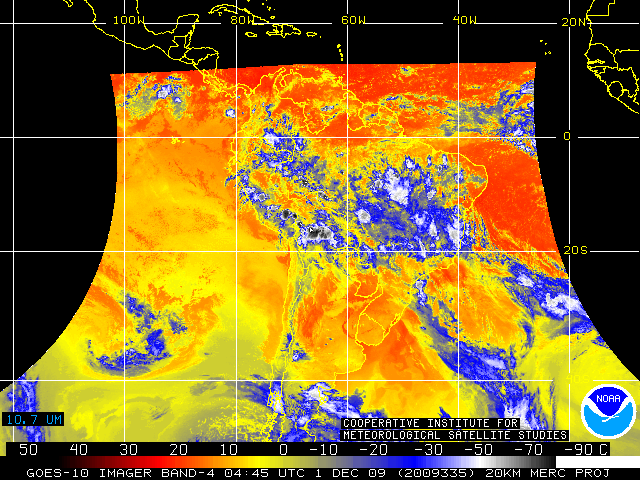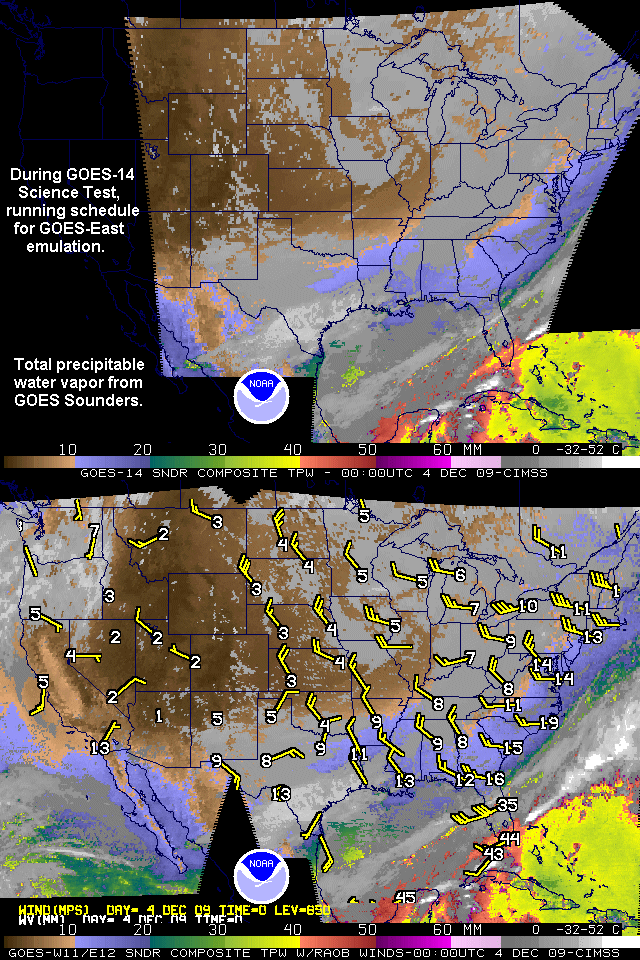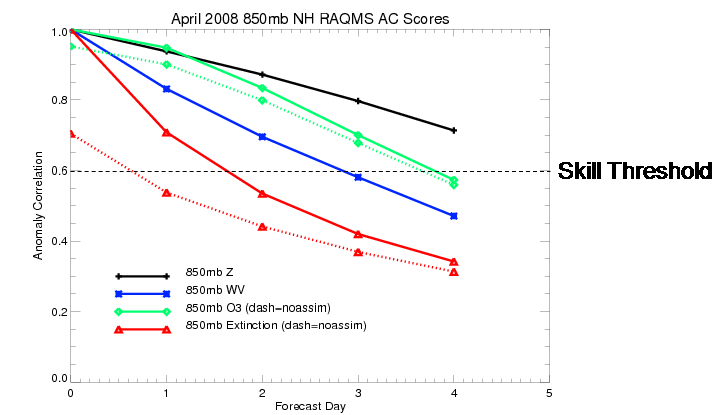
[ Archive ]

 |
ASPB and CIMSS Weekly Report
[ Archive ] |
 |
IN THE PRESS:
ITEMS FOR THE ADMINISTRATOR:
ITEMS FOR THE ASSISTANT ADMINISTRATOR:
GOES-10 Ends its Long Service: Geostationary
Operational Environmental Satellite (GOES)-10, which was located at 60W
longitude, provided information for South American and other users
after its operational years of service as the western GOES. GOES-10 has
reached its end-of-fuel life and required decommissioning on December
1, 2009. GOES-10 was launched on April 25, 1997, far
exceeding its expected lifetime. GOES-10 supplied images to the end,
including a Mesocale Convective Complex in South America (http://cimss.ssec.wisc.edu/goes/blog/archives/3879). A
"Farewell to GOES-10" is on the Cooperative Institute for Meteorological Satellite Studies (CIMSS) Satellite blog at
http://cimss.ssec.wisc.edu/goes/blog/archives/3990, covering some of
the many uses of the GOES-10 imager and sounder data. (S. Lindstrom,
CIMSS, 608-263-4425, S. Bachmeier, CIMSS, 608-263-3958, J. Nelson,
CIMSS, 608-263-6013, G.S. Wade, E/RA2, 608-263-4743,
gary.s.wade@noaa.gov, T. Schmit, E/RA2, 608-263-0291,
tim.j.schmit@noaa.gov)
Significance: The move of the GOES-10 to 60 West was a key achievement for GEOSS (Global Earth Observation System of Systems).
NOAA Mission Goal: Serve society's needs for weather and water information
NOAA Cross-Cutting Priorities: Sound, Reliable State-of-the-Art Research; Integrating Global Environmental Observations and Data Management; Leading International Activities
 (Click image to enlarge)
(Click image to enlarge)ITEMS FOR THE OFFICE DIRECTOR, STAR:
GOES-14 Processing at CIMSS: The
Geostationary Operational Environmental Satellite (GOES)-14 Science
Test period began this week (30 November 2009). Routine GOES-14 Sounder
products are being generated at the Cooperative Institute for
Meteorological Satellite Studies (CIMSS) including derived product
imagery (DPI) of total precipitable water, lifted index (stability),
and cloud-top pressure. The DPI are available at http://cimss.ssec.wisc.edu/goes/rt/sounder-dpi.php;
this website allows for easy comparison of DPI from GOES-14 with that
from GOES-11 and -12. In addition, the CIMSS Satellite Blog was updated
this week with examples of a 30-minute full disk GOES-14 animation (http://cimss.ssec.wisc.edu/goes/blog/archives/4036), improved GOES-14 Imager Image Navigation and Registration (INR) (http://cimss.ssec.wisc.edu/goes/blog/archives/4010), and fire hotspot detection (http://cimss.ssec.wisc.edu/goes/blog/archives/4053).
(S. Bachmeier, CIMSS, 608-263-3958, scott.bachmeier@ssec.wisc.edu; T.
J. Schmit, E/RA2, 608-263-0291, tim.j.schmit@noaa.gov; J. Nelson,
CIMSS, 608-263-6013, jim.nelson@ssec.wisc.edu; G. S. Wade, E/RA2,
608-263-4743, gary.s.wade@noaa.gov)
 (Click image to enlarge)
(Click image to enlarge)
Figure
caption: Top: Derived product image (DPI) of total precipitable water
(TPW) vapor derived from the Geostationary Operational Environmental
Satellite (GOES)-14 Sounder (at 105W), nominally at 00 UTC on 04 Dec
2009. Bottom: DPI of TPW from GOES-11 (at 135 W) and GOES-12 (at 75W)
at 00 UTC on 04 Dec 2009, with radiosonde values of TPW and 850 hPA
winds overlaid. Good agreement is seen between GOES-14 and the
operational GOES Sounders; the contrasting pattern of very moist air
over the Caribbean and very dry air over the west and central US is
clearly evident in both DPI.
International Workshop on Air Quality Forecasting Research: Brad
Pierce presented a talk entitled “Real-time Air Quality Modeling System
aerosol and ozone assimilation and forecasting experiments during the
NOAA ARCPAC field mission” at the International Workshop on Air Quality
Forecasting Research, December 2-3 in Boulder, CO. The talk summarized
results from global ozone and aerosol assimilation and forecasting
experiments conducted following the NOAA Aerosol, Radiation, and Cloud
Processes affecting Arctic Climate (ARCPAC) mission in April 2008.
Assimilation of real-time ozone measurements from the Microwave Limb
Sounder (MLS) and Ozone Monitoring Instrument (OMI) and aerosol optical
depth (AOD) measurements from the Moderate Resolution Imaging
Spectroradiometer (MODIS) were found to have positive impact on
Northern Hemisphere forecast skill for both ozone and aerosol
extinction. These studies provide risk-mitigation for utilization of
ozone and aerosol measurements from Ozone Mapping and Profiler Suite
(OMPS) and Visible/Infrared Imager/Radiometer Suite (VIIRS) on future
National Polar-orbiting Operational Environmental Satellite System
(NPOESS) within operational air quality prediction systems under
development at the National Centers for Environmental Prediction
(NCEP). (R.B. Pierce, E/RA2, 608-890-1892, brad.pierce@noaa.gov)
 (Click image to enlarge)
(Click image to enlarge)
Figure
caption: RAQMS 2.0x2.0 degree global geopotential height (black), water
vapor (blue), O3 (green), and aerosol extinction (red) forecast skill
with (solid) and without (dashed) ozone and aerosol assimilation during
April, 2008. The largest impacts are found for aerosol predictions
which show useful skill out to 1.5 days with MODIS AOD assimilation and
no skill without MODIS AOD assimilation. Assimilation of OMI ozone
column improves Northern Hemisphere 850mb ozone forecasts with useful
skill beyond 3.5 days. The 850mb ozone forecast skill is found to be
better than water vapor but less then geopotential height forecast
skill.
ITEMS FOR THE DIVISION CHIEF, CoRP:
Paper Accepted for Publication in JGR: A paper authored by A. Heidinger, M. Pavolonis and others was accepted this week for publication by the Journal of Geophysical Research (JGR). The paper explores the impact of the channel selection on the future NOAA imagers in the context of cloud height estimation. The paper is accessible online at http://www.agu.org/journals/jd/papersinpress.shtml#id2009JD012152. (A. Heidinger, E/RA2, 608-263-6757, Andrew.Heidinger@noaa.gov, M. Pavolonis, E/RA2, 208-263-9597, mpav@ssec.wisc.edu)VISITORS:
NEXT WEEK:
LOOKING AHEAD:
| Archived Weeklies Page | Submit a report item |